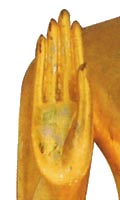Thai Buddha Hand Gestures (Mudras) Buddha Iconography
Thai Buddha Hand Gestures. The gestures performed by the hands of a Buddha image (mudras) have specific meanings that refer to some event in the life of the Buddha or denote a special characteristic. There are six main hand gestures of the Buddha in Thailand (and Asia).
 | Dhyana Mudra.
This mudra signifies meditation. Both hands are in the lap with palms upward. The right hand is on top of the left hand. The Buddha is most seated in the half-lotus posture (sometimes called ‘yoga’, ‘Indian’, ‘Buddha’ posture). Some images display the Buddha in the so-called adamantine (diamond, or full-lotus) posture with tightly crossed legs, so that the soles of both feet are visible. More. |
|
Thai Buddha Hand Gestures
 | Bhumisparsa Mudra : Subduing Mara, Calling the Earth to Witness
The left hand lies in the lap, palm upward. The right hand bends over the right knee, with fingers slightly touching the ground.
During meditation, Siddhartha is subjected to many temptations many posed by the evil Mara, who bombards him with his demons , monsters, violent storms and his three seductive daughters. The Buddha remains steadfast. Then to testify to Mara of his meritorious past, he points to the earth with his hand and calls the Earth Goddess. Thorani, the Earth Goddess rises from the ground and wrings the water from her long black hair, by this action raising a torrential flood that drowns Mara and his army of demons.
This gesture symbolizes enlightenment, as well as steadfastness (imperturbability). It is easily the most common Buddha gesture in Thai wats. More. |
|
Thai Buddha Hand Gestures
 | Abhaya Mudra – Imparting Fearlessness (Reassurance)
This gesture is made with the hand raised and the palm facing outwards, fingers extended pointing upward. The wrist is bent at a right angle with the forearm. The gesture is sometimes made with both hands. Sometimes the Abhaya Mudra is made with one hand, while another Mudra (such as Varuda Mudra) is made with the other hand.
The Buddha may be either standing, sitting or walking. More. |
|
Thai Buddha Hand Gestures
 | Vitarka Mudra – Teaching, Giving Instruction, Reason
The hand is held closer to the chest than in the Abhaya Mudra. The palm is facing outward. A circle is made with the index finger and the thumb. The other three fingers point upward. Initially made with the right hand, later on the gesture is often portrayed with both hands.
Common gesture in Dvaravati Buddha images.
Sometimes also substituted for the Dharmachakra Mudra (see below)
The Vitarka Mudra can be made while in sitting or standing position. More. |
|
Thai Buddha Hand Gestures
 | Varada Mudra – Symbolizing Charity.
The hand lowered with the palm facing outward is the gesture of bestowing blessings or of giving charity. The hand is extended downward, palm out. Mostly on standing Buddha images, but sometimes also represented in the sitting position. More. |
|
Thai Buddha Hand Gestures
[wp-review id=””]





Visitor Rating: 5 Stars